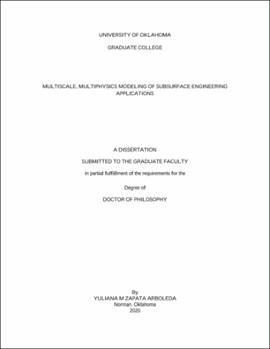| dc.description.abstract | Fluid flow, particle transport, and chemical reactions in porous media play a vital role in various disciplines, including hydrology, medicine, and engineering. In particular, in the petroleum industry, subsurface engineering applications involving injection or production of fluids are associated with physical and chemical processes at the pore-scale (nano/microscale). These processes encompass fluid-rock interactions that can determine and alter the fluid behavior and rock properties at reservoir scales (macroscale). Developing engineering tools to probe and link pore-scale processes to reservoir-scale remains a fundamental research challenge to enhance our understanding and our ability to predict the observed phenomena in the subsurface
In this work, I explored various subsurface engineering applications of multiphysics, multiscale modeling paradigms including pore-scale network models, experimental data, and reservoir scale simulation to investigate the role of physical and chemical interactions on the evolution of rock properties and fluid behavior. Three such applications were studied: (1) formation damage due to particle plugging during hydraulic fracturing as a result of proppant crushing and fluid invasion, (2) the evolution of migration pathways due to chemical diagenesis in unconventional reservoirs, and (3) plume characterization, storage mechanisms, and well-based monitoring during CO2 sequestration in saline aquifers.
First, I employed a particle plugging simulator that integrates pore-scale phenomena with hydraulic fracturing simulation at the reservoir-scale to examine the effects of fracturing fluid invasion and proppant crushing on the formation permeability damage at the matrix-fracture interface. The model is based on the generation of 3D pore networks that capture the pore space topology and serve as the frame for fluid flow and particle transport simulations. The pore networks are coupled with a commercial reservoir-scale fracture simulator that provides the fracturing process macroscale characteristics to compute the particles' retention and their effect on the formation permeability. This integrated model aims to enhance the design and modeling of hydraulic-fracturing operations in unconventional shale reservoirs by considering the pore-scale dynamics at the matrix-fracture interface.
Next, I incorporated a modeling workflow that integrates mineralogical, petrophysical, and chemical data to delve into the influence of chemical diagenesis on macroscopic properties from a pore-scale perspective. The pore-scale model proposed has two main components. The first component involves examining the depositional environment, mineralogy, and pore structure characteristics to identify diagenetic controls on the reservoir quality. The second component comprises the generation of hybrid pore network models representing the pore space, followed by the numerical simulation of fluid transport and mineral reactions related to relevant diagenetic events. The model aims to improve our understanding of the influence of diagenetic events on the migration pathways' evolution.
Finally, I investigated the geological sequestration of CO2 in saline aquifers to characterize and monitor the temporal and spatial evolution of the CO2 plume. The integrated modeling framework used provides the means to ascertain the relative influence of multiple parameters on the plume characteristics and the contributing trapping mechanisms. The selected parameters involve facies distribution, aquifer-water composition, heterogeneity and anisotropy of petrophysical properties, transport physics, and operational variables like injection rate and bottomhole pressure. Several well-based fluid variables are monitored to assess the plume evolution and identify behavior correlations between the near-wellbore and plume region properties. | en_US |

